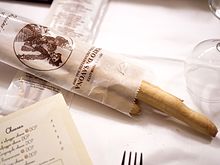Breadstick
 Grissini in a restaurant in Turin, Italy | |
| Alternative names | Grissini |
|---|---|
| Type | Bread |
| Place of origin | Italy |
| Main ingredients | Flour, water, yeast |
Breadsticks, also known as grissini (sg.: grissino; Piedmontese: ghërsin, Piedmontese: [gəɾˈsiŋ]), are generally pencil-sized sticks of crisp, dry baked bread that originated in the Piedmont region of Italy. There is also a soft-baked breadstick version popular in North America.
History
[edit]It is believed that the breadstick originated in 1643, when a Florentine abbot described a long-shaped and "bone-thin" bread being made in Lanzo Torinese, a town outside of Turin.[1][2] Tradition states, however, that it originated in the region of Piedmont in the 17th century, invented by a baker called Antonio Brunero, from Turin. It was a food that was intended to be easier to digest for the Duke Victor Amadeus II of Savoy, who had digestive problems in his childhood.[3][4][5][6]
Serving
[edit]In Italian restaurants, breadsticks are often offered as an appetizer, especially in their traditional shape, together with or replacing bread, which is commonly provided with all meals. They may also be combined with ingredients such as prosciutto. This appears to be the case with restaurants in the United States as well;[7] in some instances or regions, they may be a type that is larger than pencil-sized, as well as soft instead of hard.
While traditional grissini are plain, in the past decades there has been a push from industrial manufacturers who started exploring other flavors and shapes; examples include cumin, cheese, oregano and sesame, as well as grissini with salt crystals on the surface. These are often not the traditional pencil-thin grissini, but larger, thicker versions which are more suited for incorporating other ingredients and flavors.[citation needed]
In many North American restaurants, breadsticks are soft, frequently topped with butter, garlic, and cheese when served as appetizers; as a dessert item, they can be topped with cinnamon, sugar,[8] and icing.[9]
Pre-made, dried breadsticks can be found being sold in markets as a quick snack or a pre-meal appetizer for home use, somewhat similar to a cracker. In Italy they are often consumed as a snack on their own, but in the United States they are usually served with a dip of some sort, such as cheese.[10]
Another recipe for breadsticks, called rosquilletas, exists in the Valencian Community.[11]
-
Unbaked home-made grissini on a baking tray, seasoned with herbs
-
Wide, soft breadsticks in a basket
-
Grissini in the proper case to be served at table
See also
[edit]![]() Media related to Grissini at Wikimedia Commons
Media related to Grissini at Wikimedia Commons
- Baguette – the larger, long loaf of bread from France
- Pretzel sticks
References
[edit]- ^ "The Nibble: Breadstick History". www.thenibble.com. Retrieved 16 April 2018.
- ^ "Grissini Recipe | Italian Breadsticks | Leite's Culinaria". Leite's Culinaria. 11 November 2016. Retrieved 16 April 2018.
- ^ cobblestonewebdesign.com. "The History of Grissini". www.claudiosspecialtybreads.com. Archived from the original on 15 April 2018. Retrieved 16 April 2018.
- ^ "Grissini - Breadsticks from Piedmont with Recipe & History". blog.italian-connection.com. 7 March 2013. Archived from the original on 23 September 2018. Retrieved 16 April 2018.
- ^ "The famous Grissini of Turin are traditional breadsticks - Dear Italy Piedmont". Piedmont. 19 November 2014. Retrieved 16 April 2018.
- ^ "Grissini were invented around 1670 in Turin by a baker". Meet Piemonte. 9 September 2017. Retrieved 16 April 2018.
- ^ Joseph, Ryan (9 August 2018). "Why Olive Garden Serves Unlimited Breadsticks". Thrillist. Retrieved 19 August 2018.
- ^ Various references:
- "Cinnamon Stix rule at Jet's Pizza in Joliet". theherald-news.com. Retrieved 29 August 2018.
- "Dough-nate to Help End Childhood Hunger at Pie Five". franchising.com. Retrieved 29 August 2018.
- "30 years running, Pizza Pipeline focuses on its local roots". spokesman.com. Retrieved 29 August 2018.
- "Cinnabon Brings Back Cinnabon Stix". www.brandeating.com. Retrieved 29 August 2018.
- ^ Broyles, Tom. "Earn more dough by making some bread . . . sticks". PMQ Pizza Magazine. Retrieved 19 August 2018.
- ^ "Creamy Swiss with Classic Breadsticks". The Laughing Cow. Archived from the original on 17 April 2018. Retrieved 16 April 2018.
- ^ "Aima Rosquilletas Artesanas Hechas a Mano · Castellón". Aima Rosquilletas (in European Spanish). Retrieved 16 April 2018.





